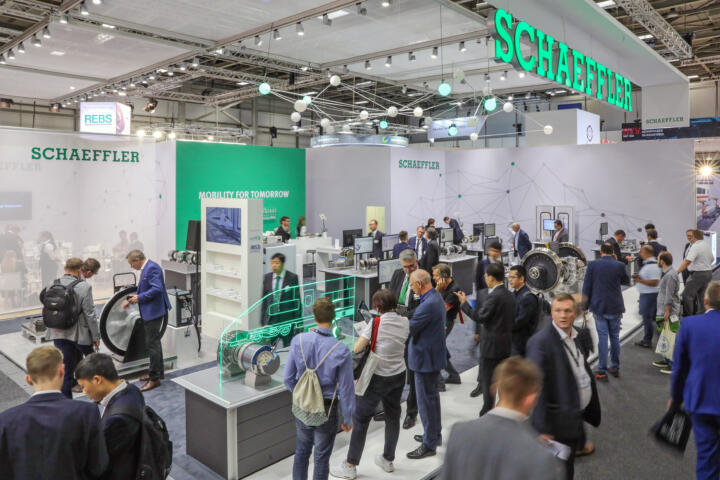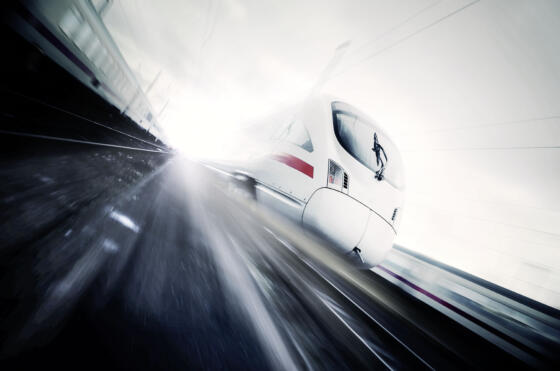
“The key to sustainability lies on the railroad tracks”
In a metaphorical sense, you’re Schaeffler’s train driver. As a child, did you want to become a train driver like so many other kids?
Even if it may surprise you, the answer is no. The job of a train driver struck me as being too specialized because back then as well as today I’ve always been interested in the railroad system as a whole: the interaction of tracks, switches, signals, trains and stations, plus the people and goods that are hauled on trains. Consequently, in the same vein as the wide variety of our systems and components in the Rail sector, I don’t see myself as a train driver but more as a rail traffic controller.
Schaeffler attributes a key role for mobility of the future to the Rail sector, especially when it comes to achieving the global climate goals. However, to do so, more passengers and goods need to be shifted to Rail, particularly in Europe. How much growth can the current European system handle? And what are areas in which improvements are needed?
The track network is divided into so-called blocks that define the distances between trains. At the moment, they’re very large. That’s partially due to the signal systems, some of which date back to the imperial era and are showing their age. Although the systems are still safe, they’re not efficient. A shift toward Europe-wide, digitized and more vehicle-bound signal systems enables a dynamic division of the blocks. For instance, by using such a European Train Control System, or ETCS for short, a lot more freight trains could have the total length of 740 meters (2,428 feet) that’s possible in Europe. At the moment, only one in ten trains is that long. The average freight train in Europe has 25 to 30 cars instead of the 35 that are possible. That alone shows improvement potential of more than 20 percent. And, of course, passenger transportation and the transportation mix of passenger and freight trains could also be organized more efficiently with ETCS.

„Both in hauling goods and in passenger transportation the trains that exist actually need to be deployed. That’s a very important issue."
Where else do you see improvement potential?
Both in hauling goods and in passenger transportation the trains that exist actually need to be deployed. That’s a very important issue. Technical failures must be reduced to a minimum. The same applies to maintenance. Schaeffler focuses on both of these areas: with innovative maintenance concepts, systems for condition monitoring and for more reliability.
When freight trains become longer do they require more locomotives to pull them?740 meters (2,428 feet) is not really long yet. Transcontinental trains in the United States have a near-endless length of seven kilometers (4,3 miles). A 740-meter (2,428-ft) train with a normal payload can easily be pulled by one locomotive while hauling as much cargo as 52 trucks. That makes the whole system of Rail so efficient and, ultimately, fascinating too.

In countries such as China, Australia and the United States you just mentioned, Rail accounts for 40 or 50 percent of cargo transportation; in the European mix, it doesn’t even account for 20 percent. How can Europe catch up?
Catching up with the countries you mentioned, and I’d like to highlight India in this respect as well, requires major changes as well as investments. In those regions, rail freight is run on dedicated corridors providing it with totally different opportunities – including financial ones. Especially in the United States, rail freight corporations like BNSF or Union Pacific are extremely profitable. In the area of separation, China is exemplary: high-speed trains, short-haul passenger transportation and freight trains have dedicated tracks, enabling totally different capacities to be handled than in Europe.
Are there any plans to establish such corridors for freight trains in Europe?
In isolated cases. For instance, there’s a freight train corridor from the Rotterdam port to the German border that’s now supposed to be extended to the Ruhr region. To shift more cargo to Rail, more projects like these would no doubt make sense.
Especially when looking at freight trains, it’s obvious that there are still many diesel locomotives in service around the globe. How can they become “clean?” Hydrogen, batteries, synfuels?
Well, first of all, it needs to be said that the energy consumed by a diesel locomotive per metric ton (1.1 short ton) hauled is around 80 percent lower than that consumed by a truck. The hard train wheels are simply running on tracks with a lot less friction than a truck tire does on asphalt. In addition, the close coupling of cargo railcars reduces train resistances. Consequently, trains per se operate with much higher efficiency. So, the decarbonization challenge is much less pressing there than it is with other transportation systems – but it does exist, as do ideas of how to achieve improvements. Looking at Europe, the issue, clearly, is electrification. Here, Germany, with a current electrification rate of the track network of less than 61 percent, is one of the countries that needs to up the ante. One reason why the electrification of locomotives is so attractive is the fact that the braking energy that’s lost in the case of a diesel locomotive can be recuperated and used. In the United States, for instance, our customer Wabtec is running a pilot project with a battery-electric and diesel locomotive hybrid consist, in other words an efficient mix of both types of drive technology that can be used anywhere.
… that works in which way?
As previously mentioned, freight trains in the United States are clearly longer and powered by several locomotives. The idea now is to include a battery-electric locomotive in that type of consist. With its 7 MW it assists in acceleration events or on inclines where the need for power is the greatest. While the train is coasting the electric locomotive shuts down and recharges its batteries while braking. As a result, even on long distances, it’s always ready to help push the train.
And what about hydrogen?
Especially in the area of long-distance cargo hauling, that’s not a truly viable solution, technically or economically, because the required amount of hydrogen cannot be hauled in reasonable ways at the moment. In regional transportation settings, where the routes are shorter and more frequent refueling is possible, the situation is different. In August, service of the world’s first network with hydrogen passenger trains started in Lower Saxony. By the end of the year, the deployment of 14 Alstom hydrogen trains is planned there – by the way, also with Schaeffler technology on board.
What’s your take on the Hyperloop hype?
Because the further development of a vehicle is always easier than the further development of infrastructure the track or road has always been simple and the lion’s share of the technological evolution has occurred on the vehicle throughout the history of mobility. That’s different in the case of the Hyperloop with its complex vacuum tubes. And that’s exactly why I tend to have a critical view of that technology. For me, the classic wheel/rail system is the gold standard. According to a popular saying among engineers, a system is always good if it’s so simple that there’s nothing left to be omitted from it. And that exactly applies to Rail and the wheelsets rolling on the tracks. It’s hard to top that interaction with a new technology, especially since there’s no physical reason why rail vehicles should not travel exactly as fast as a maglev train, for instance, or some other technology.
Going forward, what trends have the potential to evolutionize or even revolutionize rail transportation?
Of course, there’s always something than can be improved; otherwise, Schaeffler wouldn’t pursue the further development of its Rail portfolio. But talking about a revolution, the first thing that comes to my mind is the screw-type coupling for railcars. Here in Europe – unlike in other regions – technology from the century before last is still being used, requiring many manual, and even some hazardous, procedures. To finally arrive in the 21st century in this area, the EU is working on the introduction of a standardized Digital Automatic Coupling, or DAC for short, that could massively accelerate European rail freight hauling and, as a result, significantly increase its competitiveness.
Without such automatic couplings autonomous train traffic would be impossible as well …
Exactly. And that takes us to another important trend, going forward. Humans and their tendency to make mistakes are a major obstacle when it comes to enhancing the capacity utilization of the track network and putting more trains – and thus more hauling capacity – on railroads. Fully automated systems would clearly increase the efficiency of railroad operations. In addition, they could eliminate the problem of personnel shortages that the Rail sector is struggling with as well. That’s why I find it all the more surprising that so little is happening in that area.
Would better integration of the transportation systems help shift cargo to Rail?
It definitely would. From the departure points of the major European ports that’s already working pretty well. But in the case of intermodal movements in the range of 250-kilometer (155-mile) distances, Rail quickly loses out because the reloading times are simply too long or there just aren’t enough transshipment stations. Switzerland is exemplary in this regard. More than ten years ago, the country started establishing a freight train network with fixed schedules so that freight haulers can reliably plan intermodal routes. The network of transshipment sites is close-meshed and efficient too. We need such a close-meshed network of modern hubs across Europe so that combined transportation becomes competitive.
What are Schaeffler’s focal areas in the Rail business, with passenger or cargo transportation?
For us, both areas are important, but there are differences between them. In our case, passenger transportation is largely project-related business. That means that together with our customers we develop tailored solutions for specific types of vehicles. By contrast, in the freight train business, the emphasis is on standard products. Of course, that doesn’t mean that there are no developments in that area, which is also reflected in our innovations showcased at InnoTrans.
Schaeffler at InnoTrans 2022
At InnoTrans 2022 in Berlin (20 to 23 September 2022), Schaeffler will present new product solutions and pioneering systems for the entire powertrain of rail vehicles under the motto “Reliable, Predictable, Sustainable – Schaeffler Solutions for Innovations in Rail”. For further details please click here.






